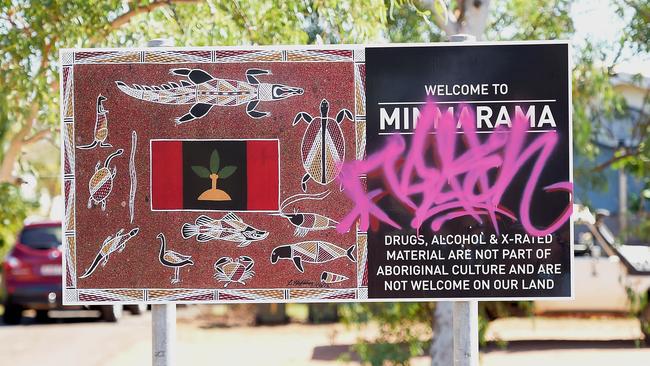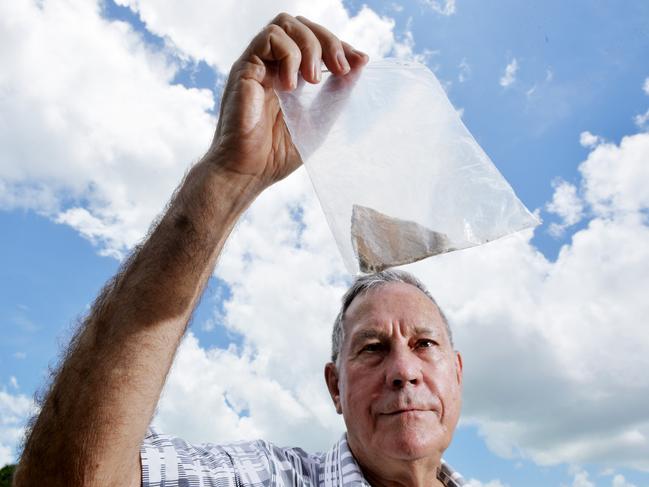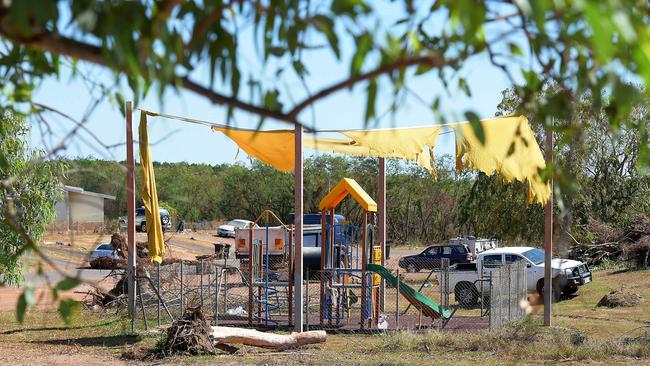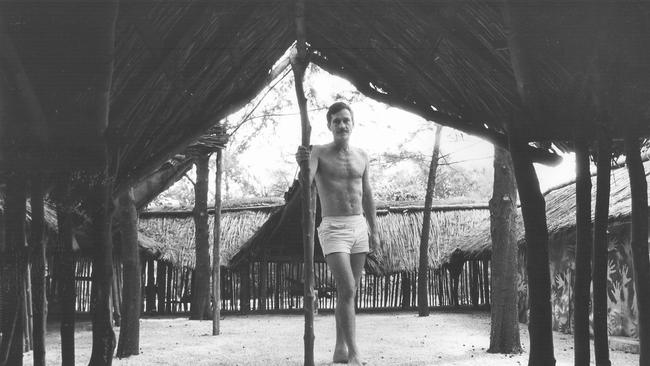Questions mount over secretive Kulaluk leaseholder’s finances
THE secretive organisation that controls more than 300ha of Crown land in Darwin’s west may be flat broke. JASON WALLS investigates

Lifestyle
Don't miss out on the headlines from Lifestyle. Followed categories will be added to My News.
“I have no doubt that the Larrakia people were the traditional owners of what is now the whole Darwin area. Some of the survivors, together with a few other Aborigines, have formed an organisation calling itself Gwalwa Daraniki. The secretary of this organisation, a white man, has achieved remarkable results in obtaining press coverage and other forms of publicity for the claims of this group. In the result, Kulaluk has become something of a symbol of the stand which Aborigines, with help and guidance from many different sources, are now making against the past tendency to put their interests last in any consideration of land usage.” A.E. Woodward — Aboriginal Land Rights Commissioner (1974)
■ ■ ■
It was the recommendations handed down by Aboriginal Land Rights Commissioner Justice Edward Woodward in the mid-1970s that would pave the way for the passage of the Aboriginal Land Rights Act in 1976.
Justice Woodward’s second and final report in 1974 ran to almost 200 pages and would in turn form the basis for the claim under the act to the land that straddles Dick Ward Dr in Darwin’s west, known as Kulaluk, by the Larrakia people which was ultimately granted in 1979.
But for anthropologist Bill Day, two passages of the lengthy report stand out in particular.
The first being that in which His Honour acknowledges the roll of the “white man” (Dr Day) in the achievements of the early land rights movement in Darwin.
The other is Justice Woodward’s view that the organisation Dr Day helped found to fight for land rights for Aboriginal people in the Top End and which was ultimately given custodianship of the lease at Kulaluk — the Gwalwa Daraniki Association — “would not be a suitable organisation to have this land vested in it”.
Four decades later, the suitability of the GDA to control the lease is just as contentious, as questions mount about the organisation’s financial sustainability and ability to manage the asset.
Today, some of those involved in the land right’s movement over the years feel they have been squeezed out by the GDA, leaving more than 300ha of Crown land in central Darwin under the control of a small, secretive and unaccountable cabal, which they say is not representative of the wider community.


Under the GDA’s original 1973 constitution “all Aborigines residing in the Northern Territory” and “any non-Aboriginal the executive may decide to admit — providing that total membership remain not less than 90 per cent Aborigines” were eligible for membership.
But that constitution was amended in 2006 and now reads: “A person is not eligible to be a member of the association unless the person is a current member of the Kulaluk Community and has lived in the Kulaluk Community for a continuous period of 12 months.”
Dr Day, who now lives in Perth, says not only does the clause shut him out but it bars membership even for many Larrakia descendants in Darwin who live outside the small communities on Dick Ward Dr.
“You’ve got 300ha of urban Darwin land controlled by a culturally anonymous group who aren’t accountable to anyone,” he says.
■ ■ ■
Various plans to develop the land have come and gone over the years — the McDonalds on Bagot Rd being one notable going concern — but a number of other plans have been announced and cash poured in only to be quietly shelved without explanation.
One such venture was a mud crab farm lauded by Federal Treasurer Peter Costello in 2006 as “a real commercial project giving training, giving jobs, making a profit and providing for the local people” which received hundreds of thousands of dollars in government funding before the business name, Mudla Farms, was mysteriously cancelled in 2008.
“I call it the Magic Pudding,” Dr Day says.
“You can sign away, have deals, get money, just keep taking it and the pudding is still there and there’s nothing there (to show for it).”
Despite the fanfare around the various projects, it remains unclear exactly where the money has gone as the announcements and grand plans fade from the public consciousness.
As an incorporated association, the GDA is required to lodge yearly financial statements with the Territory Government but has not done so for two years after being granted repeated extensions by Licencing NT.
The most recent financial statement it lodged, covering the 2015-16 financial year, shows the association made a net loss of $817,068 while maintaining “there are reasonable grounds to believe that the association will be able to pay its debts as and when they become due and payable.”
HOT OFFER: GET 7-DAY PAPER DELIVERY AND FULL DIGITAL ACCESS TO THE NT NEWS FOR $1 A DAY FOR THE FIRST 6 MONTHS
But that view was not backed up by auditors BDO Australia, who found a lack of proper record-keeping by the GDA made it impossible to conduct a review of the association’s self-assessment.
Adding to the questions surrounding the GDA’s ability to self-govern is a series of legal disputes currently or recently before the Supreme Court.
In one such dispute, the GDA was earlier this year embroiled in a row with its former lawyer, Michael Chin, who the association claimed mismanaged a development deal involving more than $1 million in rental payments that the GDA feared it may be forced to hand back.
Mr Chin denied any wrongdoing and the matter has since lapsed — though it is unclear whether the claim was withdrawn or a settlement reached.
Court transcripts from the latest hearing are revealing.
A judgment delivered in April this year by Associate Justice Vince Luppino revealed the GDA was “impecunious” and its lawyers had claimed the association was negotiating with the NT Government for “a loan of approximately $3 million to enable it to pay a taxation liability and outstanding rates and taxes”.
In handing down his decision, Justice Luppino cited “evidence of the actual, ongoing and apparently increasing losses being made by the GDA”, as well as “evidence that the plaintiff has a substantial existing liability to the Australian Taxation Office and other substantial debts for property rates and taxes”.
“In part the loan sought to be obtained from the Northern Territory was to address those liabilities. That evidence therefore shows that not only is the plaintiff making ongoing losses, the plaintiff cannot meet existing commitments,” Justice Luppino wrote.

But in response to questions from the NT News, a Planning Department spokeswoman said while it was understood the GDA “have been working on improving their financial stability” the government was not considering any loan. “It is understood that GDA were in discussions with the previous government in respect to loan funding support,” she said. “This government has not considered financial support to GDA.”
In a statement to the NT News, A GDA spokeswoman did not directly address questions about the purported loan or the GDA’s finances but said it was “working with all three levels of government in an open, accountable and transparent manner”.
“GDA are trading to the satisfaction of the deputy commissioner of taxation with the Australian Taxation Office,” she said.
“GDA receive no recurrent funding from any level of government.”
The spokeswoman said the NT Ombudsman was “working directly on a number of matters for GDA”.
■ ■ ■
Bill Day’s concerns about the management of the GDA’s finances are compounded by an apparent lack of government knowledge and oversight of what goes on inside the lease’s boundaries. Kulaluk land has been used as a dumping ground throughout the history of the lease, including at the Minmarama Community which was itself built on the site of an earlier landfill.
Dr Day has also found asbestos at the site — which the NT Environment Department acknowledges but claims poses no risk — and in June this year, he wrote to the department to share his concerns about historical and more recent dumping. The response from environment operations director Peter Vasel, in which he admitted officers had been unable to find evidence to confirm the existence of the original landfill shocked Dr Day, so he followed up with a stack of newspaper clippings from the 1970s and 1980s proving the existence of the dump.
“To me it’s a shocking, slackness, you’d call it, surely a little bit of digging would reveal something of what I’ve done myself in my own spare time,” he says.
“If they don’t know those sort of things what else don’t they know?”
After receiving Dr Day’s second letter, an Environment Department spokesman told the NT News the Environment Protection Authority had “limited records” of events prior to the establishment of Minmarama.
“These documents (provided by Dr Day) make references to the construction and operation of a relatively short-lived municipal waste disposal site beneath what is now Minmarama Village,” she said.
“The NT EPA has no ready access to this kind of historical information and thanks Dr Day for its provision.”
The spokesman said the EPA was now “investigating Dr Day’s allegations” to try to fill any gaps in its knowledge.
Dr Day also raised concerns in his letter about the dumping of construction waste into the mangroves at Minmarama in 2009, naming a construction company he believed was responsible. Mr Vasel responded that departmental officers had identified the site in question where construction rubble was dumped but were “unable to locate any permits or approvals granted by any government agency for reclamation behind Minmarama Village”.
“Officers have also been unable to determine what, if any, financial or other non-regulatory arrangements may have been in place that allowed the fill, or been able to satisfactorily determine who may have conducted these activities in 2009,” he wrote.
“That also astounds me,” Dr Day says.
The department spokesman later told the NT News the EPA had “no indication” the dumping had occurred prior to receiving Dr Day’s letter and it was unable to determine who was responsible and what materials had been dumped.
“If dumping occurs on the Kulaluk lease area and it cannot be determined who is responsible for carrying out the dumping, the responsibility to remove the material falls to the GDA,” he said.
Mr Vasel’s letter also revealed the EPA had taken action against a company found illegally dumping material in the Minmarama area in 2015.
In response to further questions about that incident from the NT News, the department spokesman said after investigating officers identified and took action against those responsible, the GDA barred its staff from the site. “Following the investigation of that incident, the GDA required that NT EPA officers only access their land with their prior permission,” he said.
“To date there has been no further reports from the Minmarama Village that have required site attendance by officers.”
■ ■ ■
Larrakia man, Eric Fejo — who lives in Darwin but not on the Kulaluk lease and as such is excluded from membership of the GDA — says the old people he watched fight for land rights in the 1970s and who “claimed Larrakia country back” by raising the nation’s flag over the courthouse in Darwin in 1972, would be disappointed by the current divisions.
Mr Fejo calls Bill Day “an old champion for the Aboriginal people” who “educated the old people on how white governments do their business”.
“That was the first flag raised by a sovereign people in this country and that was a non-indigenous man’s design, old Bill Day, that was his design, but the design was a special place at Kulaluk which is the nest and where the water spring is there,” he says.
“With the education that he had, you’ve got to understand, back then there was creole, pidgin getting spoken and for many of them English was a third or fourth different language, so to have a person like Bill there gave them a bit of a better understanding of how things worked in the Westminster system.” While Mr Fejo declines to comment on where it all went wrong for the GDA, he is adamant the “whole area was handed back to all Larrakia people” and should not be in the hands of one small group.
“I’m not into this black bashing, we get enough of it from everyone else, it’s just really, really disappointing that things have gone this way,” he says. “I know them old people, they’d be rolling in their graves, all the struggles, the hard times they went through. Today these so-called leaders that we’ve got now, they’re the role models for our future and it’s scary, it’s bloody scary.”
■ ■ ■
The GDA spokeswoman declined to answer a series of questions from the NT News but said in a statement it was the GDA’s policy not to comment on private or commercial matters.
“I certainly won’t be commenting on the vexatious and spurious questions brought about by the usual NIMBY suspects that continue to hold old grudges against GDA with hatred in their hearts,” she said.


